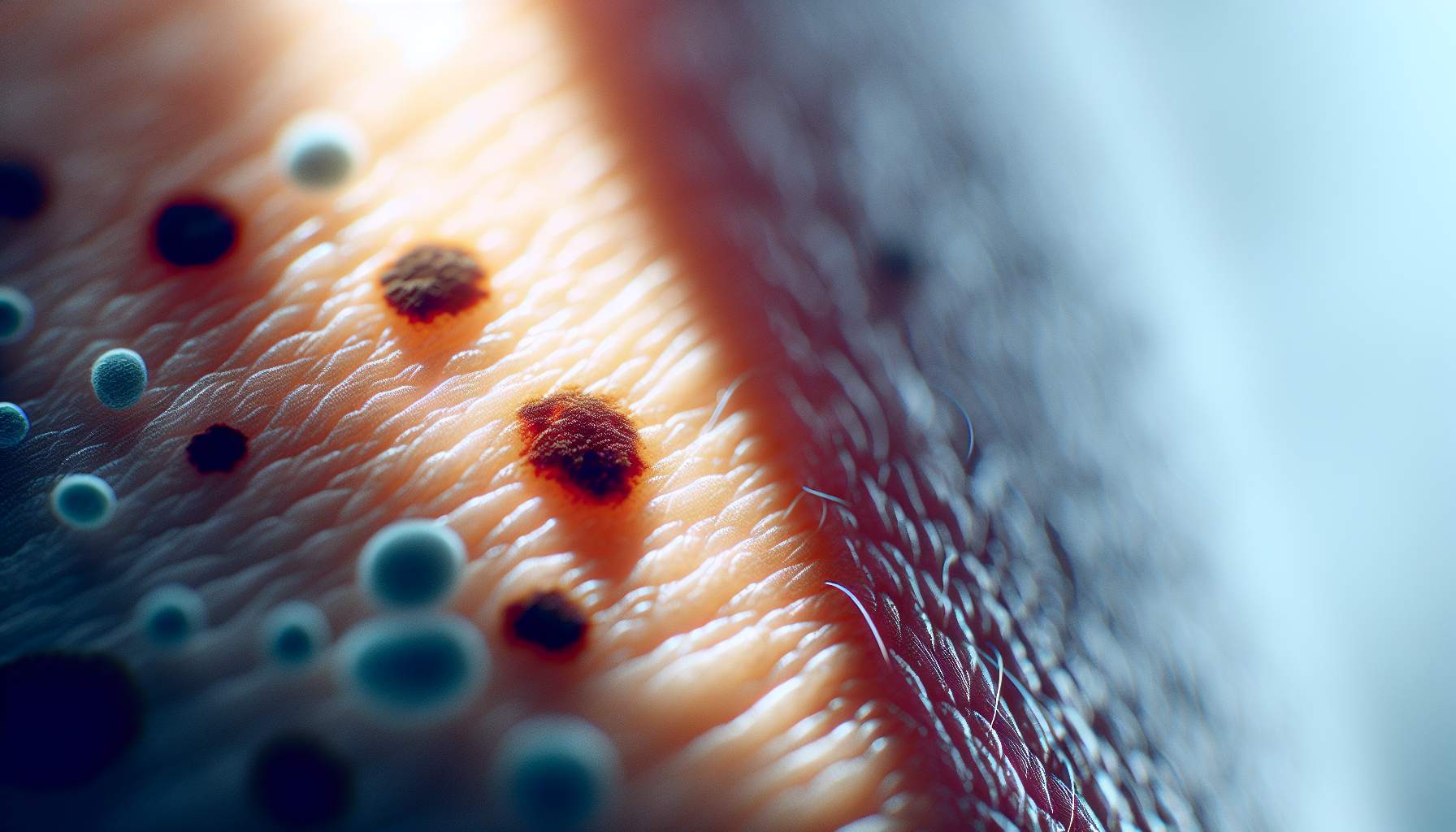Annually, the United States records over five million new instances of skin cancer, making it the nation’s most prevalent cancer type. Astonishingly, by the age of 70, one out of every five Americans will have battled this disease. Highlighting and educating the public about this significant health concern is imperative.
To address this issue head-on, May has been designated as National Skin Cancer Awareness Month. This crucial period aims to shed light on the importance of understanding skin cancer, its widespread impact, and why paying attention to it matters greatly for everyone’s well-being.
Knowing about this campaign is vital for several reasons. It not only educates individuals on how widespread skin cancer is but also promotes preventive measures that could save lives. Through awareness efforts during May each year, people learn more about early detection methods and ways to protect their skin from harmful UV exposure—key elements in reducing one’s risk of developing skin cancer.
In essence, National Skin Cancer Awareness Month serves as a powerful reminder of a health challenge we collectively face but can overcome with proper knowledge and actions. Recognizing its significance ensures that more individuals take steps towards protecting themselves effectively against skin cancer—a goal we should all strive towards.
Understanding National Skin Cancer Awareness Month
May in the United States is dedicated as National Skin Cancer Awareness Month. This time serves as a vital window for everyone to boost their understanding of skin cancer—spanning its types, stages, treatments, and preventive measures. The initiative isn’t just about spreading knowledge; it’s also aimed at transforming behaviors towards more sun-safe practices with the ultimate goal of saving lives.
Getting involved is a great way to make a difference. Whether you’re looking to deepen your own understanding or help others become more aware, there’s plenty you can do. By focusing on skin health education and promoting protective habits against harmful sun exposure, we can all contribute to reducing the impact of skin cancer.
Discussing Cancer
The Big See initiative is all about keeping an eye out for early signs of skin cancer. It’s crucial to spot anything on your skin that’s new, looks different, or seems off. Spreading awareness about this effort is key; it could be a lifesaver by fostering prevention and aiding in catching skin cancer early when it’s most treatable.
Increasing Awareness
May is the perfect month for both learning and teaching. Consider spreading the word about various kinds of skin cancer, their warning signs, and ways to prevent them.
Telling Your Story on the Internet
If you’ve battled with skin cancer, sharing your journey could shine a light on this issue and bring it to life. Consider posting videos or comments online to tell others about your experience. It’s a straightforward way to make an impact.
Key Facts on Melanoma and Skin Cancer
In the United States, skin cancer tops the chart as the most frequently diagnosed cancer. By their seventieth birthday, approximately 20% of Americans will have faced a battle with this disease. It’s a startling statistic that underscores just how pervasive skin cancer has become.
One silver lining in this cloud is the high success rate in treating melanoma, one of the deadliest forms of skin cancer when it’s caught early. A staggering 99% of people diagnosed with early-stage melanoma are likely to survive beyond five years. This highlights the critical importance of vigilance and regular check-ups.
The sun’s ultraviolet (UV) rays play a significant role in this health crisis, being responsible for about 90% of all non-melanoma skin cancers. It seems no tan is worth risking your health over, especially considering that women are particularly susceptible to non-melanoma types.
Alarmingly enough, more than a million individuals in America are battling melanoma at any given time. Over the last ten years alone, there’s been nearly a 50% spike in new melanoma cases – an increase that can’t be ignored.
Melanomas prove fatal more often than not when they progress too far without detection or treatment. Remarkably though, around half of these cases start with someone noticing changes in their own skin and taking action — an empowering reminder of how crucial self-awareness and regular self-exams can be.
These statistics aren’t just numbers; they’re wake-up calls for everyone to pay closer attention to their skin health and prioritize protection against UV exposure every day.
Various Kinds of Skin Cancer Explained
Skin cancer arises when the cells on the skin’s surface start behaving erratically. But it’s not a one-size-fits-all situation; there are actually several variants of this disease you might encounter. Knowing these types is step one in keeping yourself safe. Experts from the Skin Cancer Foundation point out that we’re mainly looking at four prevalent forms here.
Understanding these distinctions isn’t just academic—it’s critical for safeguarding our health against this common yet preventable condition. So, before diving headfirst into prevention strategies, wrapping your head around these categories is essential.
Understanding Basal Cell Skin Cancer
Annually, over four million individuals in the United States are diagnosed with basal cell carcinoma (BCC), the most prevalent form of skin cancer. This condition arises when basal cells, located in the skin’s outermost layer, begin to grow abnormally. Typically, these abnormal growths appear on parts of the skin that get a lot of sun exposure. Common spots include behind the ears, on the face, neck, scalp, shoulders, and back.
Understanding this health issue is crucial for early detection and treatment. Being aware of which areas of your body are more likely to be affected can help you keep an eye out for any unusual changes or growths. Remembering to protect your skin from excessive sun exposure can also play a significant role in preventing BCC from developing in the first place.
Skin Cancer: SCC
Squamous cell carcinoma develops from the squamous cells that form the surface layer of the skin. It stands as the United States’ second most frequently diagnosed skin cancer, with over a million new cases each year. Typically, this cancer makes its appearance on skin areas that have soaked up a lot of sunlight, highlighting the hazardous impact of UV radiation exposure.
Understanding Skin Cancer
Melanocytes are the cells responsible for giving our skin its unique color. However, when these cells start growing uncontrollably, melanoma can occur. This is a severe form of skin cancer that might initially look like an ordinary mole but could show signs of change such as alterations in color, size, or shape.
Melanoma stands out as the most perilous variant of skin cancer due to its aggressive nature in later stages. Being vigilant about any new or changing moles and seeking professional advice promptly can be crucial in managing this health risk effectively. With awareness and timely intervention, the dangers posed by melanoma can be significantly reduced.
Understanding Merkel Cell Carcinoma
Merkel cell carcinoma (MCC) stands out as a less common form of skin cancer, yet it’s one that demands attention due to its severity. Typically manifesting as hard, sometimes pain-free lumps on the surface of the skin, MCC doesn’t play around—it’s known for its aggressive nature and tendency to come back even after treatment. This makes catching it early crucial in the battle against skin cancer. Prompt recognition and action can significantly impact outcomes, emphasizing why staying vigilant about changes in our skin is more important than ever.
What Causes Skin Cancer?

Both the lifestyle decisions you make and your genetic background play significant roles in determining your vulnerability to skin cancer. Gaining insights into how these elements influence your susceptibility enables you to adopt protective measures moving forward. Armed with knowledge, you’re better positioned to minimize your risk.
In this regard, Macmillan Cancer Support sheds light on several key factors that contribute to skin cancer risk:
Understanding these components is crucial for anyone looking to safeguard their health against skin cancer. By staying informed, making wise choices becomes second nature, significantly enhancing your defense against this disease. Remember, being proactive about prevention is a powerful step towards maintaining long-term well-being.
Exposure to UV Rays
Being out in the sun too much can lead to skin cancer, which is mainly caused by ultraviolet (UV) light. When your skin gets burned from the sun or exposed to a lot of UV light, you’re more likely to get two common types: basal cell carcinomas and squamous cell carcinoma. That’s right – those nasty sunburns aren’t just painful; they could be dangerous in the long run.
Now, if you find yourself turning into a lobster every time you step outside, watch out. You’ve got a higher chance of catching these cancers. It’s like playing with fire, except it’s not fire; it’s sunlight. So, what do you do? Well, it’s pretty straightforward: shield yourself from the sun as if your life depends on it because, well, it sort of does.
Slather on that sunscreen like butter on toast, generously and often. Dress up as if you’re going undercover; hats and long sleeves are your best friends now. And those tanning beds that promise a golden glow? They’re more like glowing traps for UV rays to zap you. Giving them a wide berth is smart.
In essence, enjoying the great outdoors doesn’t mean baking under the sun unprotected. A bit of prep goes a long way in dodging those harmful rays and keeping your skin cancer-free. Remember, there’s no such thing as being too careful when safeguarding against something as sneaky as UV rays.
Cancer Treatment with Radiation
If you’ve ever received radiotherapy treatment for a medical condition, it’s crucial to be aware of its potential long-term effects. Such treatments are known to increase the risk of developing various skin cancers, including basal cell carcinomas (BCCs). This means that if you’ve been treated with radiotherapy in the past, paying close attention to your skin’s health as you age is more important than ever.
Being proactive about recognizing the early signs of skin cancer can make a significant difference. It’s all about staying one step ahead and ensuring that any unusual changes don’t go unnoticed. Regular check-ups and consultations with healthcare professionals should become a priority. After all, being informed and vigilant is your best defense against the unforeseen consequences that might arise years after undergoing radiotherapy.
Weakened immune system
If your immune system isn’t performing at its best, you’re more likely to fall prey to certain skin cancers. A weakened immunity can stem from various factors. Among the leading culprits are the use of drugs that suppress your immune response, battling HIV, or dealing with blood-related malignancies such as chronic lymphocytic leukemia (CLL). These conditions make it harder for your body to fend off illnesses, including aggressive forms of skin cancer. Therefore, staying informed about what affects your immune strength is crucial for early prevention and effective treatment strategies.
Understanding Bowen’s Disease
Bowen’s disease, also recognized under the medical term squamous cell carcinoma in situ, represents a form of skin anomaly characterized by abnormal cell growth on the skin’s surface layer. Individuals diagnosed with this condition face a significant risk that these abnormalities could evolve into more serious forms known as squamous cell carcinomas (SCCs) if not addressed promptly. Given these potential developments, securing an early diagnosis and initiating appropriate treatment becomes crucial to managing the disease effectively.
Chemical Exposure
Working in environments where chemical use is frequent can escalate the risk of developing skin cancers, a less common but serious health hazard. It’s crucial for individuals employed in such sectors to actively seek and implement safety measures. One effective step could be communicating with supervisors to secure enhanced protective equipment or strategize ways to minimize direct contact with hazardous substances. Ensuring personal safety in these settings not only safeguards one’s health but also contributes to a safer workplace culture.
Hereditary Disorders
Skin cancer, while primarily influenced by environmental factors, can also have a genetic component. Families with lighter skin tones are inherently more vulnerable to the disease. Characteristics such as pale complexion, freckles, and a propensity to burn when exposed to sunlight significantly raise the likelihood of contracting skin cancer. Additionally, individuals with rare genetic disorders like Gorlin syndrome or xeroderma pigmentosum (XP) carry an increased risk of facing this health challenge.
Understanding one’s familial and genetic predisposition towards skin cancer is crucial for prevention and early detection. It’s not just about staying out of harm’s way; it’s about being informed and proactive in safeguarding your health against potential risks that lurk beyond our control.
Former skin cancer patient
If you’ve already faced skin cancer and received treatment for it, staying vigilant against its recurrence is crucial. Your healthcare provider will guide you on measures to prevent the disease from returning. Remember, it’s possible for cancer to reappear either in the same spot or elsewhere on your body. Therefore, keeping an eye out for any symptoms by conducting regular self-examinations is essential. This proactive approach can help catch signs early and increase the likelihood of successful management should the disease return.
Examining Your Skin for Cancer Signs
Understanding the risks associated with skin cancer is vital, but knowing how to proactively check for it is equally important. The first step in this process involves educating oneself on what to look out for. This knowledge serves as a powerful tool in recognizing signs early and taking swift action towards your health.
Here are some straightforward strategies to help you keep an eye out for potential warning signs:
– Familiarize yourself with common indicators of skin cancer through thorough research and consultation with healthcare professionals.
– Regular self-examinations play a crucial role. Make it a habit to inspect your skin systematically, searching for any new or changing marks.
Keeping these points in mind can significantly aid in catching skin conditions early on, when they’re most treatable. Remember, being informed and vigilant about changes in your body is the key to safeguarding your well-being against skin cancer.
Identifying Skin Cancer Indicators
Catching skin cancer early is crucial for your well-being. Recognizing its symptoms promptly can significantly increase the success of treatments. Skin cancer comes in various forms, each with unique indicators you shouldn’t overlook. Experts from the American Cancer Society emphasize that observing any signs associated with this condition should prompt immediate attention.
Indicators of melanoma
Uneven birthmarks or moles might catch your eye, especially if their edges seem jagged or fuzzy. Watch for any shifts in color within these spots, as well as any noticeable growth in their overall size. If you spot these marks changing shape, color, or expanding over time, it’s worth a closer look.
Indicators of basal cell skin cancer
Skin conditions can manifest in various ways, signaling potential health issues that shouldn’t be ignored. One common indicator is the appearance of smooth, light-colored or yellowish patches on the skin’s surface, suggesting an area that might require medical attention. Additionally, some individuals may notice peculiar shiny lumps, ranging in hue from soft pinks to more pronounced reds. These growths stand out not only for their glossy texture but also because they possess a somewhat see-through quality.
Darker shades can also emerge within these anomalies; hues like blue, brown, or black often dot the landscape of such bumps, hinting at a deeper complexity beneath the skin. Another telltale sign includes elevated areas of reddened skin which could lead to discomfort due to itchiness—an irritation that prompts a scratch but offers no relief.
Moreover, one cannot overlook open wounds that stubbornly resist healing with time—a concerning symptom signaling underlying issues needing professional evaluation. In certain cases, distinctive pink protrusions make an appearance on the skin’s exterior. These particular growths are notable for their raised edges and concave centers—a hallmark feature indicating something amiss.
Understanding and recognizing these symptoms is crucial for maintaining skin health and ensuring timely intervention when necessary. It’s always better to err on the side of caution and consult with healthcare professionals upon noticing any unusual changes in your skin’s condition.
Indicators of Squamous Cell Carcinomas
Bumpy growths that sometimes have a dip in the center can appear on your skin, resembling warts and popping up anywhere. You might also find scaly, rough patches that are reddish and prone to bleeding. Then there are those persistent sores that just won’t close up no matter how much time passes.
Additional worrisome signs
When you spot a wound that won’t close up or notice new, unusual spots on your skin, it’s time to sit up and take note. Skin discomfort such as itching or sensitivity can also be a sign that something’s not quite right. Moreover, if you see any inflammation or color change around a mole, or if a mole itself undergoes noticeable alterations in texture or hue, these are clear signals that shouldn’t be ignored. Particularly concerning is when the pigment of a spot begins to bleed out into the surrounding skin.
In situations like these, reaching out for medical advice promptly is the smart move. Although these symptoms may not necessarily mean you’re dealing with skin cancer, they warrant professional evaluation. Consulting with a healthcare expert can provide peace of mind and clarity on what could be causing these changes in your skin. It’s crucial to remain alert and regularly inspect your body for any unusual changes—better safe than sorry!
Use a DNA test kit at home
If you’re fretting over the potential for skin cancer, it’s crucial to weigh in on how much your genes influence this risk. It turns out that family history plays a significant role; individuals from families with a predisposition towards certain skin types are more likely to face this challenge. Additionally, those inheriting specific rare conditions like Gorlin syndrome or xeroderma pigmentosum find themselves at an elevated risk.
Home DNA testing kits offer a proactive approach for those concerned about their susceptibility to skin cancer. These tests not only evaluate your overall cancer risk but also how your skin responds to sun exposure—a key factor in many cases of the disease. By exploring some of the top DNA testing options available, you can arm yourself with critical information that could aid in early detection and prevention strategies.
Genetic Testing Simplified
Navigating the vast world of genetics and health has been made significantly easier thanks to 23andMe. This platform simplifies the process of understanding your genetic makeup, whether you access it through their straightforward website or opt for the convenience of their app. Opting for the Health + Ancestry Service offered by them provides a deep dive into your genetic predisposition towards certain medical conditions, including various cancers.
Moreover, this service doesn’t stop at just presenting your risk factors; it goes a step further by evaluating whether you might carry genes that could be passed on to future generations. The carrier status report sheds light on 44 congenital conditions, offering valuable insights into your potential role in transmitting these genes to your children. With this detailed information at hand, you can make informed decisions about how your genetics may influence not only your own health but also that of your family’s future generations.
The Essence of Hue
Exploring the impact of your genetic makeup on your health has never been easier, thanks to Color. This innovative health kit digs into the realm of population genomics, a field that examines statistical risk levels, to shed light on how your DNA influences your overall wellness. One standout feature of choosing Color is its comprehensive report, which notably includes a section dedicated to cancer.
Understanding the role genetics plays in cancer can be crucial. A single change in one’s genes might elevate their risk for this formidable disease. Therefore, equipping yourself with knowledge about your genetic predisposition can be a proactive step towards safeguarding your future health.
The scope of cancers covered by Color is broad; it spans hereditary, familial, and even sporadic cancers. For instance, if skin cancer runs in the family, this test could be instrumental in gauging your own susceptibility to it. Armed with such pivotal information, you’re better positioned to engage with healthcare professionals. Discussing these findings allows you to get personalized advice and plan effectively for preventive measures or necessary actions tailored specifically for you.
In essence, Color‘s approach empowers individuals by providing them with detailed insights into how their genes might influence their health trajectory—particularly concerning cancer risks. It acts as a bridge between genetic knowledge and practical health decisions, enabling informed discussions with doctors about potential next steps in managing one’s personal health journey.
Unraveling Your Genetic Secrets
Almost 9 out of 10 nonmelanoma skin cancers have their roots in exposure to ultraviolet (UV) rays. This startling statistic underscores the importance of understanding your skin’s response to sunlight, which can be crucial for its protection. The Skin Care DNA Kit by 24Genetics offers a deep dive into this subject, providing insights that could play a vital role in safeguarding your dermal health.
The report generated by the kit spans a variety of topics related to skin wellness, such as the natural aging process and how your body interacts with certain vitamins and minerals. A significant part zeroes in on your skin’s behavior under sun exposure. It outlines several key areas including:
– Your sensitivity towards sunlight
– The risk of developing photo-aged skin
– How prone you are to tanning
– Your likelihood of getting sunspots
It’s worth noting that the scientific evidence supporting these findings is not robust at this stage. Despite this, the information gleaned from the report can still offer valuable guidance on how to enhance your skin care regimen for better sun protection.
In essence, while it may not substitute for professional medical advice or comprehensive scientific research, leveraging insights from the Skin Care DNA Kit could empower you with knowledge about your unique dermal makeup. This awareness can pave the way for informed decisions regarding your skincare practices, potentially minimizing sun-related risks and fostering healthier skin over time.
Genetics of the Future
Futura Genetics has rolled out a comprehensive health DNA test that scrutinizes 28 widespread conditions, including eight different types of cancer. This detailed analysis equips you with the necessary information to take charge of your health proactively, allowing you to fend off prevalent diseases by making informed lifestyle and health decisions.
Moreover, individuals who have previously undergone DNA testing through 23andMe have the added advantage of importing their raw data into Futura Genetics for further insights. Beyond mere data interpretation, this service offers actionable advice and preventive measures aimed at reducing the risk of disease development.
It’s crucial to engage with a healthcare provider after receiving your report. A doctor can leverage the insights from your DNA test to provide personalized guidance and strategies tailored to maintaining or enhancing your well-being. Embracing this knowledge about potential health risks empowers you to make choices that could significantly impact your long-term health positively.
The Main Point
National Skin Cancer Awareness Month serves as a crucial reminder of the significance of skin health. It’s an ideal time for individuals to deepen their understanding of skin cancer types and to share knowledge with others. Awareness about the signs of skin cancer and methods for safeguarding oneself are vital components in promoting overall well-being. By actively participating, you can contribute to disseminating crucial information on this topic.
Educating yourself and those around you on the prevention and early detection of skin cancer could make a monumental difference. It’s not just about absorbing information; it’s about initiating conversations, sharing insights, and encouraging proactive measures towards protection against harmful sun exposure. This month offers a platform for everyone to rally together, enhancing community health literacy and fostering an environment where protecting our skin becomes second nature.
Remember, staying informed and vigilant is paramount. Let’s use this month as a springboard for action—embrace the opportunity to extend your knowledge, engage with your community, and advocate for healthier living practices that could save lives.
Additional Tools
If you’re eager to dive deeper into the realm of skin cancer knowledge and discover ways to safeguard yourself, a wealth of resources is at your fingertips. To quench your thirst for answers or expand your understanding, consider exploring these valuable sites:
– Dive into The Skin Cancer Foundation website. It’s a treasure trove of information dedicated to educating individuals on how to prevent, detect, and treat skin cancer.
– Check out what the American Academy of Dermatology has on offer. Their insights on skin health are not only profound but also backed by experts in dermatology.
– The American Cancer Society provides comprehensive details not just about skin cancer but various other types as well. Their guides can arm you with knowledge that could be life-saving.
– Lastly, don’t miss out on visiting The Big See. It’s an innovative platform aimed at encouraging early detection through engaging content and stories from those who’ve had firsthand experiences with skin cancer.
These websites serve as excellent starting points for anyone looking to get informed about skin cancer. From prevention tips and detection strategies to treatment options, they cover all bases. So go ahead, explore these resources and arm yourself with the knowledge necessary to protect your skin from the sun’s harmful rays.



















